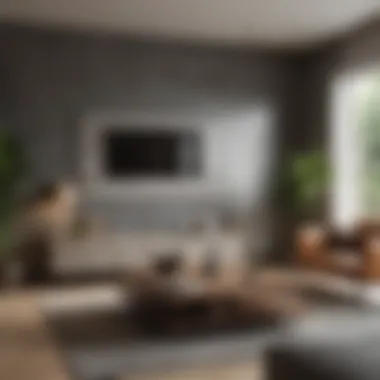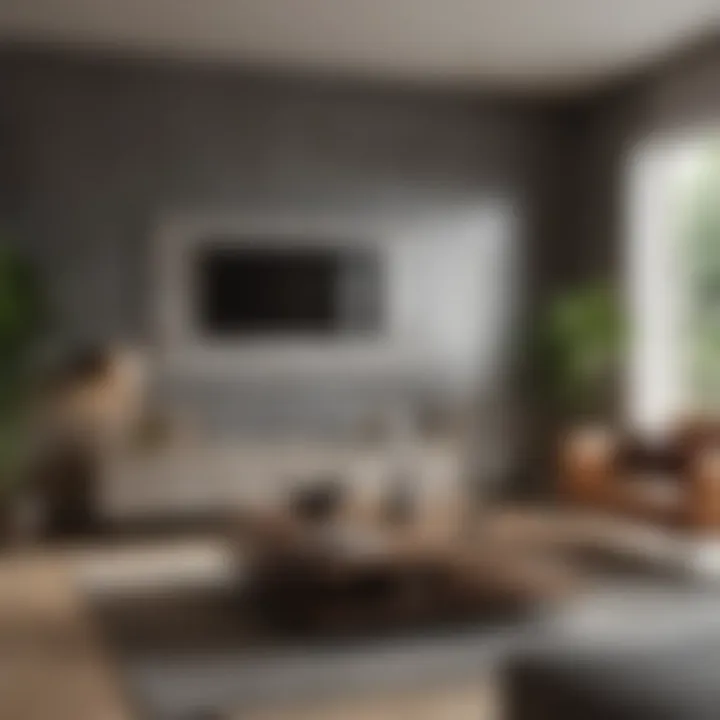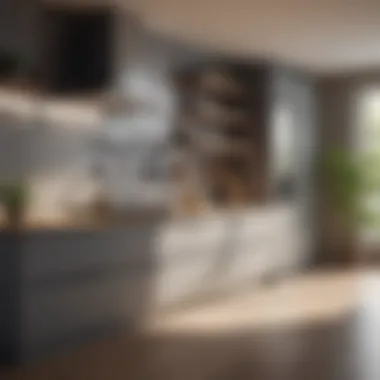Creative Strategies for Effective Home Organization


Intro
The psychological benefits of a tidy home are significant. A well-organized environment can boost productivity, reduce stress, and even cultivate a sense of peace in one's living situation. However, achieving this order requires more than just an occasional cleaning spree; it needs intention, planning, and oftentimes, a fresh perspective on how we view our spaces.
Certainly, the route to a carefully curated home involves examining various organization methods. These methods are not just about creating more space but are also about fostering a lifestyle that values simplicity and sustainability. From assessing trending styles that can inspire our layouts to understanding the importance of maintaining our organized spaces, the following sections will guide you step-by-step through this essential endeavor.
Understanding Home Organization
When discussing home organization, it’s crucial to grasp its significance not just as a matter of aesthetics but as a reflection of our inner lives. An organized home isn’t just visually appealing; it serves many deeper purposes that can transform daily living. By diving into the realm of organization, we not only create spaces that welcome us but also foster mental clarity and productivity.
One might wonder how scattered belongings can cloud thoughts or hinder efficiency. To illustrate, consider a scenario where you’re hosting friends for dinner. If your living areas are cluttered, that stress may overshadow the joy of socializing. An organized space paves the way for a smoother experience, allowing you to focus on the people, not the mess.
Benefits of Home Organization:
- Reduced Stress Levels: Clutter can be overwhelming; by organizing your space, you can lessen anxiety.
- Enhanced Focus and Productivity: A tidy environment helps the mind concentrate better, leading to improved efficiency.
- Higher Value of Your Home: Homes that are well-maintained and organized often attract better offers on the market.
But organization doesn’t merely stop at cleaning; it involves creating systems that work for you. That's where we start defining what organization truly means.
Defining Organization
In simple terms, organization refers to the act of arranging or structuring elements within a space. This doesn’t mean everything must be in a certain order, like a sterile neatness, but rather it’s about finding a rhythm that fits your lifestyle. For instance, maybe you have a penchant for art supplies scattered across the table or gardening tools laid everywhere. Organization can look vastly different from one home to another.
An important part of defining organization is figuring out individual needs. Do you often juggle many tasks or hobbies? This directly influences how areas of your home should be structured. You might create a vibrant craft corner where colors and supplies blend, enhancing creativity. If you have kids, a play area organized by age or activity can aid in both fun and ease of use.
Why Organization Matters
Understanding why organization matters goes beyond immediate clean spaces. At its core, a well-organized environment encourages a lifestyle that prioritizes clarity over chaos. Here are key aspects of this:
- Time Management: When you can find things easily, you save time. For instance, having your gardening tools in one manageable kit means fewer moments wasted searching for that elusive trowel.
- Mental Well-being: Studies have shown that clutter can affect mental health. A soothing space can contribute to feelings of peace and relaxation, while clutter can create distractions and stress.
- Promoting Better Habits: An organized space can cultivate discipline. Simply returning items to their designated places fosters habits of mindfulness and respect for personal belongings.
"An organized home is not just a living space; it's a reflection of who you are, contributing to a life that feels balanced and intentional."
In the grand scheme of things, understanding home organization is about unearthing the potential within spaces we inhabit. Make no mistake, it’s not merely a chore but a profound acknowledgment of how we interact with our surroundings. As we weave through practical strategies in this article, keep these underlying principles in mind. They’ll serve as a guide and reminder of the impact that organization can have—not just on spaces, but on lives.
Evaluating Your Current Space
Evaluating your current space is like surveying the battlefield before diving into a fight. You wouldn’t charge ahead without knowing what you’re up against, right? Similarly, understanding your living environment allows you to tackle organization challenges with purpose. A careful assessment reveals the nooks and crannies where clutter lurks and identifies areas that can be optimized for better functionality.
By taking a hard look at your space, you can prioritize what really matters and eliminate what doesn’t. This process doesn’t just improve aesthetics but can enhance your mental well-being as well. When your environment aligns with your needs, it fosters a sense of calm and focus. It’s not merely about tossing out items; it’s about bringing clarity into your day-to-day life. The benefits of this crucial step are undeniable: greater efficiency, improved mood, and possibly even increased creativity.
Assessing Clutter Levels
When it comes to assessing clutter levels, the first step is taking stock of your belongings. This isn't just about appearances; it's about the overall functionality of your space. Start in one room and gradually work your way through the house. Look for items that have outlived their usefulness or items that simply don’t fit in anymore.
- Visual Inspection: Take a good look around. Are there piles of stuff everywhere? Clothes strewn about? Items gathered on surfaces? If you can see clutter, there's likely more lurking beneath.
- Sentimental Value: Determine what items are essential for emotional reasons. This can be tricky since many people hold on to things for nostalgia. Ask yourself: "Does this item bring me joy?" If it doesn't, consider letting it go.
- Functionality Assessment: Evaluate if your belongings serve a purpose. For instance, if you haven't used a blender in six months, it may be time to rethink its place in your kitchen.
- Create Categories: Use tags like "keep," "donate," and "dispose." This division helps clarify your thoughts and makes the process seem less overwhelming.
Identifying Problem Areas
Once you've assessed the overall clutter level, it's time to pinpoint problem areas in your home. These areas are where chaos reigns supreme, and solutions are most needed.
- High Traffic Zones: Focus on places that get the most action—hallways, entryways, or kitchen countertops. Stuff tends to accumulate in these areas because they’re frequently used.
- Storage Spots Gone Rogue: Look at your closets and drawers. Are they overflowing? Can you even find what you need? These should be reset, as they often become voids where organization goes to die.
- Personal Spaces: Assess how your personal spaces—like your home office or hobby room—are working for you. Does it inspire you, or does it feel cluttered and chaotic? If the latter is the case, you might have more than just a little cleaning to do.
- Outdoor Areas: Don’t forget about patios or gardens. Shed disarray can creep into outdoor spaces too. What was once a relaxing spot may become a dumping ground for garden tools and unused furniture.
Taking the time to evaluate your current space sets the foundation for an organized, tranquil environment. Remember, the goal is to create a living space that works for you, not against you.
Decluttering Strategies
Decluttering isn't just a trend; it's a necessity for creating organized, tranquil living spaces. It serves as the foundation upon which all other organizational methods stand. Practicing effective decluttering strategies can dramatically impact the feel of your home, making it more livable and pleasant. It's not solely about getting rid of things you don't use; it’s about enacting a change in how you perceive your belongings and their role in your life.
The Power of Minimizing Possessions
To start with, minimizing possessions goes beyond just clearing out clutter. It's about recognizing the emotional and psychological ties we build with our things. Many homeowners find themselves clinging to items that no longer serve a purpose, from worn-out clothes to outdated decor. One effective mindset shift is to ask yourself: "Does this item add value to my life?" If the answer is no, it's probably time to let it go.
Having fewer possessions can lead to a fragmernted sense of calm and clarity. A less cluttered space often translates to a less cluttered mind, allowing you to focus on what really matters.
- Benefits of Minimizing Possessions:


- Improved mental clarity.
- Easier to maintain cleanliness.
- Enhanced aesthetic appeal of your home.
- Increased value of the items you do keep.
The Four-Box Method
The Four-Box Method is a practical technique that can simplify the decluttering process. This method requires you to prepare four labeled boxes:
- Keep: Items that you use regularly or that bring you joy.
- Donate: Items that are in good condition but no longer serve you.
- Trash: Broken or unusable items that should just be discarded.
- Undecided: Items that you're not ready to part with but which need further consideration.
This method encourages deliberate decision-making about your belongings. Each time you encounter an item, placing it in one of the four categories helps to prevent indecision, streamlining the decluttering process. For many, once they see the physical results of their efforts, they feel motivated to keep going.
In the Moment Decision Making
In the hustle of daily life, making organization decisions can often fall to the wayside. This is where "In the Moment Decision Making" becomes critical.
This strategy emphasizes making immediate choices about what to keep or discard as you encounter each item rather than allowing clutter to build up over time. It's about training your brain to engage with your surroundings actively.
Being mindful in these moments helps combat procrastination and reassures you that every small effort counts. Consider the following:
- If you haven't used it in the last year, will you really use it again?
- Does it create joy or add strain?
- Are you keeping it out of obligation or genuine desire?
"Every time you decide to let go of something, you make space for something new to come in."
Using these decluttering strategies can transform not just your space, but also your mindset regarding belongings, leading to a more intentional lifestyle.
Storage Solutions
In the realm of home organization, storage solutions are like the backbone of a well-structured living space. They hold the entire system together, enabling homeowners to maintain order amidst the hustle and bustle of daily life. Proper storage not only helps in reducing clutter but also enhances the efficiency of how spaces are utilized. Considerations about how to best utilize storage options can make a significant difference in achieving a serene environment.
When discussing storage solutions, we should also consider how they contribute to the overall aesthetic of a house. Creative and thoughtful storage can beautify your home while making it functional. Incorporating functional designs into your storage can harmoniously blend utility with style.
Smart Use of Vertical Space
Let's face it; when it comes to storage, we often think of floors and horizontal surfaces. However, vertical space is a treasure trove that often goes underappreciated. Walls can be transformed into storage units, giving you the chance to reclaim precious floor area.
For instance, think about installing floating shelves. They are versatile and can accommodate books, ornamental pieces, or even kitchen items, thus elevating your decor while keeping things tidy. Consider also using wall-mounted racks or hooks for frequently used items. This not only clears your surfaces but also makes your essentials easily accessible.
Another idea is to consider customized cabinetry that reaches up to the ceiling. Not only does this provide additional storage, but it also draws the eye upwards, creating an illusion of more space. Vertical storage solutions aren’t just practical; they can also be a major design element!
Utilizing Multi-functional Furniture
In today's fast-paced world, multi-functional furniture is like a Swiss army knife for home organization. It’s not merely about the furniture's function; it's about the intelligent use of space. Think of a coffee table that doubles as a storage chest or an ottoman that opens up to reveal hidden compartments. Each piece cleverly adapted to do more than just one job helps declutter a living area.
A sofa bed, for instance, serves as both a couch and a sleeping arrangement. Perfect for the impromptu guest—keeping your home welcoming yet functional. Additionally, foldable dining tables offer flexibility for your space, expanding during gatherings but tucking neatly away after. This versatility is crucial for creating an organized home.
Creative Container Ideas
Containers can be more than just boxes. They can be style statements. Embracing creative container ideas can turn mundane organization into a visually appealing display. For example, using glass jars not only serves as storage for pantry items but also adds a touch of rustic charm to your kitchen.
Consider labeled baskets for a charming look that can organize anything from toys to crafting supplies. They give a warm, homey feel while containing the clutter.
Here are some ideas to consider:
- Vintage suitcases for storing blankets or seasonal clothing while adding character to your decor.
- Color-coded bins to categorize your storage, making it easier to find what you need without tearing everything apart.
The key is to choose containers that not only fulfill functional requirements but also resonate with your personal style, making organization feel much less like a chore and more like a delightful accomplishment.
"Organization isn't just about discipline; it's about creating a space that mirrors your personality while functioning effectively."
Through the integration of thoughtful storage solutions, the goal is to help you shape not just a functional living environment but an expressive one. The heart of a well-organized home starts with storage, and making the right choices could lead to transformative outcomes.
Creating Functional Zones
Creating functional zones within your home is like drawing lines on a map; it delineates territory. These zones help organize space by assigning specific areas for activities, thereby enhancing efficiency and flow in daily life. Whether it's a cozy reading nook or a play area for the kids, defining these spaces brings structure to home life. This section explores why creating functional zones matters and how to implement them effectively.
Designated Spaces for Activities


Every activity needs its dedicated terrain. When you designate spaces for cooking, relaxing, or crafting, you streamline the experience. For instance, if you love to cook, having clearly defined areas for prep, cooking, and cleaning can make the process smoother. Think about it—the last thing you want is to trip over a chair while searching for that elusive spatula during a big meal. By segmenting these zones, you can easily navigate your tasks.
- Identify activities: Take a moment to jot down what activities happen most in your home.
- Assign zones: Based on your list, create specific areas that accommodate related functions.
- Utilize storage: Use containers and shelves that match each zone's purpose to maintain order.
Defining Common Areas
Common areas are the beating heart of a home. These are the spaces where family and friends gather. Defining these zones encourages social interactions while still managing to declutter. Ideally, these shared spaces should blend function and comfort. It's where you enjoy your morning coffee or binge-watch a series with friends.
Here are some ways to define common areas:
- Furniture arrangement: Position seating in a way that encourages conversation. For example, a semi-circle of couches fosters interaction.
- Cleaning routines: Decide on a regular cleaning protocol for these communal spaces to ensure they remain welcoming.
- Decorative cues: Use rugs or lighting to subtly demarcate the boundaries of these zones.
Balancing Privacy and Openness
Creating zones involves a delicate dance between privacy and openness. While you want to encourage interaction in common areas, it’s essential to provide moments of solitude. In larger homes, this can be tackled by strategically placing rooms or utilizing partitions.
Consider these strategies to balance both:
- Visual barriers: Use bookcases or indoor plants to create a sense of division without forming hard walls.
- Flexible furniture: Incorporate movable partitions or folding screens that can adjust based on your needs throughout the day.
- Sound management: Soft furnishings can help absorb sound, creating a quieter environment in more private areas.
"Creating zones can make all the difference; it balances chaos with peace, fostering an orderly home life."
Having functional zones helps every member of the household understand how to use the space effectively. It can cater to individual needs while fostering community—perfect for family dynamics or friendly gatherings. Organizing a home shouldn’t feel daunting; it's about setting up practical systems that reflect how you and your loved ones live.
Incorporating Sustainable Practices
In today’s world, the push towards eco-friendliness and sustainability has taken center stage. It is no longer just a trend but a necessity. The act of incorporating sustainable practices into home organization doesn’t merely create a visually pleasing environment; it fosters a deeper connection between the individual and their surroundings. Here, we discuss how sustainability is intricately linked to organization by exploring various aspects that enhance both eco-friendliness and efficiency.
One pivotal benefit is the reduction of waste. By choosing sustainable methods, homeowners can minimize their carbon footprint while creating a space that feels fresh and inviting. Furthermore, environmentally conscious choices often lead to budget-friendly solutions, since reusing and repurposing materials can save money in the long run. There is also something fulfilling about finding innovative ways to make the most of the materials already at hand, lending a unique touch to any living space.
Eco-friendly Materials for Storage
When diving into sustainable organization, selecting eco-friendly materials for storage is crucial. This does not only mean opting for products that are biodegradable or recyclable. It also encompasses utilizing materials that are sourced responsibly. For instance, bamboo is a fantastic alternative to traditional wood. Not only does bamboo grow quickly, but it also offers strength and durability, making it perfect for shelving and storage solutions.
Another option to consider is using recycled materials like old crates or repurposed wooden pallets. Not only do these materials bring character to a room, but they also tell a story that resonates with mindful consumers. Varieties of fabric organizers made from recycled cotton or hemp are also wise choices to consider, as they are sustainable yet stylish.
"Sustainable choices in home organization reflect a growing awareness of our environment and its impact on our lives."
Recycling and Upcycling Solutions
Recycling and upcycling are fantastic ways to reinvent how one organizes their living space. Instead of discarding items that no longer serve a purpose, consider how they might be transformed into something new and functional. Old glass jars can easily be turned into chic storage containers for kitchen utensils or office supplies. In a similar vein, worn-out furniture can be given a second life through simple refurbishing techniques such as painting or re-covering with repurposed fabric.
The beauty of upcycling lies in its creativity. It not only results in unique pieces that reflect personal style, but it also diverts waste from landfills. As a result, each upcycling project can be a conversation starter for guests while showcasing a commitment to sustainability.
Here are a few practical tips for incorporating easy upcycling solutions at home:
- Turn banners into wall art: Use old fabric banners or scraps of material to create appealing decor.
- Convert wooden pallets into shelves: Pallets that were once destined for the rubbish heap can be transformed into functional storage.
- Use wine bottles as decor: Collect and spray-paint wine bottles to use as vases or candle holders.
In essence, embracing sustainable practices in home organization not only results in creating a cohesive and clean living space but also showcases a commitment to the planet. Each small step, whether it's choosing eco-friendly materials or engaging in recycling and upcycling activities, can significantly transform a home into an organized sanctuary that resonates with individual values.
Maintaining Order Over Time
Maintaining order in one's living space is not just a task but a commitment. It’s easy to declutter and organize, especially when motivated by a fresh start or a desire to beautify your surroundings. However, keeping that order in place requires a different mindset, one that acknowledges the ebb and flow of life. A sustained organization strategy means establishing habits that facilitate ongoing tidiness in your home while allowing it to adapt to your changing needs.
Establishing Organization Routines
Routines form the backbone of long-term organization. Think of it as a cycle of habits that become second nature over time. Here are some practical approaches:
- Daily Tidying: Dedicate a few minutes each day to put away items that belong to different spaces. Whether that’s the book you read last night or a pair of shoes left in the hallway, returning items to their homes neutralizes clutter before it accumulates.
- Weekly Checks: Schedule a specific time each week to reevaluate the organization in various areas of your home. Look for any areas that may be slipping back into disorder. It helps to set aside time for this; through consistent reinforcement, you encourage a sense of control.
- Seasonal Overhaul: At the start of each season, consider conducting a more thorough review of your possessions. This is the perfect time to reassess items in closets and the garage, decluttering as necessary and ensuring that everything is in tip-top shape for the months ahead.
Establishing these routines may initially feel like a chore. Yet, like any skill, the more you practice, the more it becomes ingrained. Soon enough, it feels less like a chore and more like a form of self-care that enhances your living experience.
Reviewing and Adjusting Strategies
No plan is perfect from the start. It's essential to regularly review and adjust your organizing strategies based on what truly works for your lifestyle. The organization is not a one-size-fits-all endeavor.


- Assess Effectiveness: Take time to evaluate whether your current strategies are effective. For example, if you notice papers piling up on the desk despite having a designated filing system, it may be time to explore simpler systems or more visible reminders.
- Be Open to Change: Life changes; families grow and shrink, hobbies shift, and so do the seasons of our lives. Each time you adapt, different organizational needs arise, and it’s vital to remain flexible. If a specific area of your home fails to serve its purpose, don't hesitate to reconfigure that space.
- Engage Household Members: Organizing isn’t an individual pursuit; incorporate input from those who share your space. Hosting a family meeting to share thoughts on organization might reveal preferences and ideas you hadn’t considered. Everyone's buy-in creates a culture of organization in the home.
By understanding that organization is a journey rather than a destination, you foster a resilient environment that holds itself together. "Organization is like the invisible glue that helps us manage life’s chaos, making it easier to navigate."
Ultimately, maintaining order over time not only preserves a well-managed household but also heightens the overall quality of life. It cultivates a space where comfort, functionality, and aesthetics converge harmoniously.
The Psychology of Organization
Understanding the psychological underpinnings of why and how we organize our living spaces can be a game-changer. The way we interact with our belongings isn't just about the physical act of tidying up; it taps deep into our emotional and behavioral patterns. It can influence our mental health, productivity, and overall satisfaction with our home environment. To tackle organization effectively, it's crucial to explore the psychological aspect and its benefits, such as attaining a sense of control, reducing anxiety, and fostering a more inviting atmosphere.
Understanding Behavioral Patterns
Our habits in organization are often reflections of deeper behavioral patterns. Have you ever noticed how clutter accumulates? It can stem from a variety of factors, including lack of time, emotional attachment, or even external stressors. As a homeowner, being aware of these tendencies can help you break the cycle of disorganization.
Understanding how you react to clutter provides insights into your organizing habits. For instance, if you find yourself shoving items into boxes during busy periods only to revisit chaos later, there’s a behavior pattern at play that suggests avoidance. Exploring strategies to confront these patterns consciously can not only streamline your living space but also nurture a sense of achievement.
- Keep a log of when clutter tends to build up.
- Recognize the emotional triggers that impact your organizational behavior.
- Set small, incremental goals to encourage positive behavior shifts.
Emotional Attachment to Belongings
It’s important to recognize that our belongings often hold sentimental value. The coffee mug your friend gave you from that unforgettable trip, or the old book that reminds you of your childhood, all evoke emotions that can complicate the decluttering process. When you try to organize, consider how these attachments influence your decisions on what to keep or toss.
Sometimes, it can feel like letting go of items equates to letting go of memories, and that’s a tough pill to swallow. To navigate this emotional terrain, think about the role these possessions play in your current life. Ask yourself:
- Does this item enhance my daily life?
- Does it evoke positive memories, or is it a burden?
- Are there alternative ways to honor these memories without keeping the item?
Being mindful of what you choose to hold onto can lead to a more intentional selection of belongings, ultimately resulting in an organized space that truly resonates with your life now.
"A well-organized space is not just a reflection of physical order, but a state of mind that cultivates clarity and peace."
Understanding and addressing both behavioral patterns and emotional attachments arms you with powerful tools for thoughtful organization. With this knowledge, you can craft a living environment that not only satisfies aesthetic norms but also respects your emotional landscape.
Organizing for Personal Needs
When it comes to home organization, catering to personal needs can make all the difference. Each individual and family has unique preferences, lifestyles, and challenges that can influence how space is utilized. Prioritizing these specific elements not only promotes efficiency in managing belongings but also enhances the emotional connection individuals feel towards their living environment. By acknowledging that one size doesn’t fit all, we can create tailored solutions that resonate with the inhabitants of the space.
Considerations for Family Dynamics
In any household, understanding family dynamics is a crucial factor in organizing effectively. Each family member brings their own set of needs and habits to the table, which can complicate the organization process. For example, parents might value having an organized play area for children, while teenagers may need their personal spaces that reflect their individuality.
- Involve Everyone: It’s important to involve all family members in the planning stage. This helps to ensure that everyone feels heard and valued.
- Establish Common Goals: Discuss what organization looks like for the family. Is it having a clear pathway in the living room? Is it finding a place for all sports equipment?
- Create Shared Spaces: Designate areas that are easily accessible for communal items. This might be a corner of the entryway for shoes, backpacks, and outdoor gear. Acknowledge common touchpoints and plan storage solutions accordingly.
Utilizing feedback from all ages can spark creativity and even lead to solutions that change the way the family interacts with the home. When children see their opinions matter, they are more likely to take ownership in keeping spaces tidy.
Tailoring Strategies for Different Lifestyles
Life is not a linear path; it’s a winding road with many twists and turns. This reality calls for flexible organizing strategies that cater to various lifestyles. For instance, a busy professional will have different needs compared to a retiree who enjoys crafting or gardening.
- Busy Lifestyles: Incorporate time-saving solutions. For instance, installing a few hooks next to the door can provide a quick hang-up place for bags and coats when you're rushing out.
- Families with Children: Consider the accessibility of items. Create lower shelves where toys and books are easily reachable for smaller hands, allowing children to participate in the organization process.
- Hobbies and Interests: A gardening enthusiast might prefer a designated gardening station, while an art lover could need a space for their supplies. Having tailored spaces helps in minimizing clutter and enhances creativity.
Creating a practical yet personalized approach elevates the standard of home organization. It transforms living spaces from mere environments into havens that reflect the inhabitants' daily realities and aspirations, ultimately fostering a sense of belonging and well-being.
Ending: Achieving an Organized Space
When we talk about organization, it's about far more than just putting things in their rightful places. It’s about creating a home that nurtures peace of mind and efficiency. In this ever-busy world, the value of an organized space cannot be overstated. Ultimately, it is the culmination of many practices and principles that allows for relaxed living, clarity, and ease. The journey toward organization doesn't need to be a race; rather, it’s a gradual process of transforming chaos into a canvas of harmony.
The Long-term Benefits of Organization
An organized home yields countless advantages, many of which become increasingly apparent over time. At its core, organization can streamline daily tasks, making the mundane feel less burdensome. Here are some notable benefits:
- Reduced Stress: Clutter often feeds anxiety. When our spaces are tidy, our minds can breathe a little easier, resulting in decreased tension.
- Enhanced Productivity: When everything has its place, you waste less time searching for items, finding it easier to focus on priorities.
- Improved Aesthetics: An organized home is not just functional; it’s also visually appealing, contributing to an atmosphere that feels welcoming and tranquil.
- Increased Sustainability: By keeping a well-organized home, it becomes clearer to evaluate what items are truly necessary, reducing excess buying and promoting a sustainable lifestyle.
These benefits are important reasons to adopt a structured approach to organizing your living spaces, ensuring that they not only meet your daily needs but also support your long-term well-being.
Embracing the Journey of Organization
Organization is not a one-time event; instead, it is a journey, hopeful and evolving. It’s natural to fall back into old habits, but the important part is to embrace the learning process. Each step, even if it seems small, contributes to the larger picture of a well-ordered life. Consider these aspects:
- Start Small: Focusing on one space or category at a time can yield quicker results and motivate further action. A drawer here, a closet there.
- Adapt and Adjust: What works today may not work tomorrow. Being flexible in your approach allows you to discover methods that best suit your lifestyle.
- Celebrate Achievements: No matter how minor the task seems, take a moment to appreciate your efforts. This acknowledgment fuels motivation for the next phase of your journey.
Ultimately, achieving an organized space is about more than just order; it's about crafting an environment that reflects your values and enriches your life. Whether you're hosting a gathering or tending to your garden, you'll find that an organized home lets you live fully in the moments that matter.















